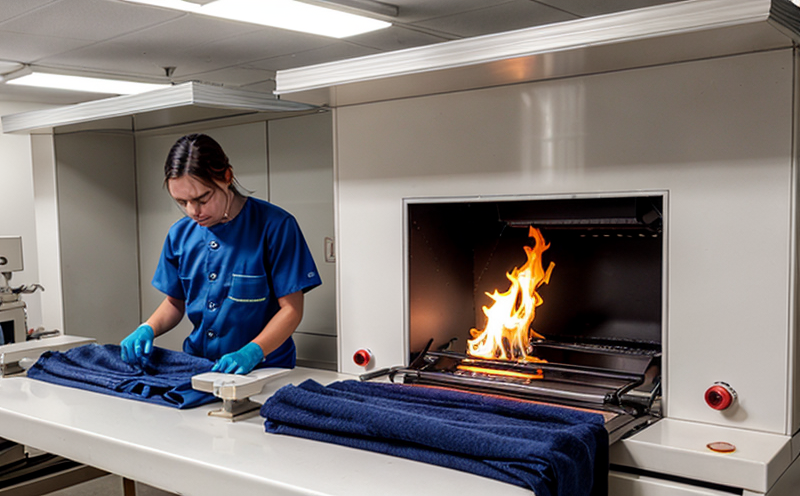Fire Resistance Testing of Blended Fabrics
The fire resistance testing of blended fabrics is a critical aspect of ensuring product safety and compliance with international standards. This service involves assessing how well a fabric composed of multiple fibers (such as cotton, polyester, and other synthetics) can withstand exposure to heat or flame without igniting easily or burning excessively. The ultimate goal is to protect end-users from potential hazards in high-risk environments such as healthcare facilities, industrial settings, and public spaces.
Blended fabrics are widely used due to their enhanced performance characteristics compared to single-fiber textiles. They offer better durability, comfort, and resistance against shrinking or stretching. However, the unique composition of these materials also makes them more challenging to test for fire safety. The testing process requires specialized equipment capable of simulating real-world exposure scenarios accurately.
One common method used in this type of testing is the Vertical Flame Test (ASTM D6413), which measures the flame propagation rate and flaming duration after exposing a sample to direct flames. Another important test is the Horizontal Flame Test, focusing on the behavior of fabric when exposed horizontally to a radiant heat source. These tests help determine whether the material meets flammability regulations set forth by organizations like NFPA (National Fire Protection Association) in North America or BS 5852 in Europe.
In addition to these standard tests, there are other methods tailored specifically for blended fabrics:
- Smoldering Test
- Thermal Stability Testing
- Flame Spread Index Measurement
The process begins with careful preparation of the fabric samples according to specified dimensions and weight requirements. Specimens must be cut free from defects that could affect test results. Afterward, they undergo rigorous testing under controlled conditions using advanced instrumentation such as flame testers and calorimeters. Data collected during these experiments form the basis for evaluating compliance with relevant standards.
Compliance is crucial because non-compliant products may pose significant risks to consumers if exposed to fire hazards. For example, improperly treated clothing worn by medical staff could catch fire more readily than compliant garments, increasing the likelihood of burns or other injuries during emergencies. Similarly, furniture upholstery made from non-compliant fabrics might contribute to rapid spread of flames in case of a fire outbreak.
By leveraging our expertise in performing thorough fire resistance tests on blended fabrics, we ensure that your products meet strict regulatory requirements while maintaining high levels of quality and reliability. Our state-of-the-art facilities equipped with cutting-edge technology allow us to provide accurate and reliable test results quickly. This enables you to bring safer products to market faster and stay ahead of competitors.
Let's discuss how our comprehensive testing services can benefit your business today!
Frequently Asked Questions
Benefits
Conducting fire resistance tests on blended fabrics offers numerous advantages beyond mere compliance with regulations. Firstly, it enhances product safety by identifying any weaknesses or vulnerabilities within the material's structure that could lead to rapid ignition or prolonged burning once exposed to flames. Secondly, successful completion of these tests boosts brand reputation and customer trust since satisfied buyers are less likely to switch brands due to concerns about product safety.
Moreover, manufacturers who invest in fire resistance testing gain valuable market insights into consumer preferences regarding fabric quality and durability. They can then tailor their offerings accordingly, potentially leading to increased sales volume as well as higher profit margins.
Environmental and Sustainability Contributions
- Reduces the risk of accidental fires
- Promotes sustainable manufacturing practices by encouraging the use of safer materials
- Encourages recycling efforts through improved product design based on test findings
By ensuring that blended fabrics pass stringent fire resistance tests, we contribute positively towards environmental protection and sustainability goals. This is because preventing accidental fires reduces waste generation associated with firefighting activities. Additionally, promoting safer manufacturing processes leads to reduced emissions from hazardous chemicals used in treatment processes.
Use Cases and Application Examples
| Application Scenario | Description |
|---|---|
| Hospital Gowns | Blended fabrics used in hospital gowns should be highly flame-resistant to prevent accidental ignition during surgical procedures or other medical treatments. |
| Furniture Upholstery | For furniture upholstery, fire resistance testing ensures that even if a flame source comes into contact with the material, it will self-extinguish quickly without causing extensive damage or injury. |
| Uniforms for Firefighters | The outer layers of firefighting uniforms are often composed of blended fabrics that need to withstand intense heat and flames while providing protection against heat transfer. |
- Incorporating flame-resistant additives into the fabric during manufacturing improves its overall fire resistance performance.
- Implementing proper design changes such as adding barriers between layers of material enhances the effectiveness of fire resistance.





